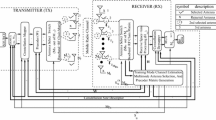Abstract
Layered Steered Space-Time Codes (LSSTC) is a recently proposed multiple-input multiple-output system that combines the benefits of vertical Bell Labs space-time (VBLAST) scheme, space-time block codes and beamforming. We suggest a new downlink scheme employing LSSTC with asymmetric power allocation, by assuming that the user feeds the BS with the average signal-to-noise ratio per VBLAST layer through the uplink feedback channel. The motivation behind proposing such a system is to enhance the error performance by assigning power to the layers in an optimal manner. We refer to the system proposed as the optimal power allocation LSSTC (OPA-LSSTC). Our analysis is general such that it includes asymmetric layered systems in which each layer may have different number of antennas and also the power can be assigned to layers asymmetrically.
Similar content being viewed by others
References
Wolniansky, P. W., Foschini, G. J., Golden, G. D., & Valenzuela, R. A. (1998). V-BLAST : An architecture for realizing very high data rates over the rich-scattering wireless channel. URSI international symposium on signals, systems and electronics (pp. 295–300).
Alamouti S. (1998) A simple transmit diversity technique for wireless communications. Selected Areas in Communications, IEEE Journal on 16(8): 1451–1458
Tarokh V., Naguib A., Seshadri N., Calderbank A. (1999) Combined array processing and space-time coding. Information Theory, IEEE Transactions on 45(4): 1121–1128
Mohammad, M., Al-Ghadhban, S., Woerner, B., & Tranter, W. (2004). Comparing decoding algorithms for multi-layered space-time block codes. IEEE SoutheastCon proceedings (pp. 147–152).
Chong, J. H., Khatun, S., Noordin, N. K., Ali, B. M., & Syed, M. J. (2008). Joint optimal detection of ordering SIC ZF and SIC ZF MAP for V-BLAST/STBC wireless communication systems. ENICS ’08: proceedings of the international conference on advances in electronics and micro-electronics (pp. 84–89).
El-Hajjar M., Hanzo L. (2007) Layered steered space-time codes and their capacity. Electronics Letters 43(12): 680–682
Kostina V., Loyka S. (2008) On optimum power allocation for the V-BLAST. Communications, IEEE Transactions on 56(6): 999–1012
Nam, S. H., & Lee, K. B. (2002). Transmit power allocation for an extended V-BLAST system, 2002. In The 13th IEEE international symposium on personal, indoor and mobile radio communications, 15-18 Sept. 2002 (Vol. 2, pp. 843–848).
Chen H.-Y., Chuang C.-H., Yeh P.-C., Zummo S. (2010) Optimal power allocation and power control for VBLAST systems with M-ary modulations. IET Communications 4(8): 956–966
Nam S. H., Shin O.-S., Lee K. B. (2004) Transmit power allocation for a modified V-BLAST system. IEEE Transactions on Communications 52(7): 1074–1079
Wang N., Blostein S. D. (2007) Approximate minimum BER power allocation for MIMO spatial multiplexing systems. IEEE Transactions on Communications 55(1): 180–187
Wang, N., & Blostein, S.D. (2005). Minimum BER transmit optimization for two-input multiple-output spatial multiplexing. In Global telecommunications conference, 2005. GLOBECOM ’05. IEEE (Vol. 6, pp. 3774–3778).
Kalbasi R., Falconer D., Banihashemi A. (2005) Optimum power allocation for a v-blast system with two antennas at the transmitter. Communications Letters, IEEE 9(9): 826–828
Proakis J. (2000) Digital communications (4th ed.). McGraw-Hill, New York, USA
Salim, A. (2010). Performance of layered steered space-time codes in wireless systems, Master’s thesis.
Al-Shalan, F. (2000). Performance of quadrature amplitude modulation in Nakagami fading channels with diversity. Ph.D. dissertation, King Fahd University of Petroleum and Minerals, Dhahran, Saudi Arabia.
Tao, M., & Cheng, R. (2001). Low complexity post-ordered iterative decoding for generalized layered space-time coding systems. IEEE international conference on communications (Vol. 4, pp. 1137–1141).
Author information
Authors and Affiliations
Corresponding author
Rights and permissions
About this article
Cite this article
Salim, A.S., Zummo, S.A., Al-Ghadhban, S.N. et al. Optimized Power Allocation for Layered-Steered Space-Time Codes. Wireless Pers Commun 68, 95–113 (2013). https://doi.org/10.1007/s11277-011-0441-1
Published:
Issue Date:
DOI: https://doi.org/10.1007/s11277-011-0441-1




